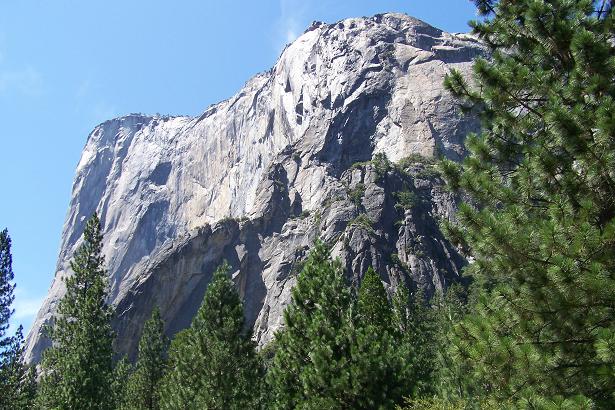YOSEMITE – As the deadline for comment on the Merced River Plan approaches, concerned citizens are voicing their opinions with letters to the Park Superintendent. The comment period ends on Thursday, Apr. 18.
Here is a comprehensive breakdown some of the concerns expressed by Wendy Brown-Barry and Kevin D. Barry in their letter to Don Neubacher.Dear Mr. Neubacher:
My husband and I are horse owners and long time residents of Mariposa County. Our main form of recreation is trail riding and camping in the back country. We are very concerned about how the Merced River Plan is going to affect not only stock users, but people from all walks of life who value a variety of recreational activities in Yosemite National Park, YNP.
We are also founders of “Yosemite For Everyone.” This group of dedicated individuals and concerned citizens believes in a common sense approach to preservation where visitor use is balanced with protecting the environment, and they support recreational activities that have been traditionally and historically enjoyed in Yosemite for 150 years.
After reading through the 2,500 pages of your Merced Wild and Scenic River Draft Comprehensive Management Plan and Environmental Impact Statement, (which we did not receive in a timely manner), we have come to the conclusion that it is seriously flawed. No alternative is acceptable in this Plan. The only alternative that we would consider would be the No Action, Alternative 1, with some improvements made for traffic flow and parking. Removing any other recreational activities or amenities from the Park is completely unacceptable to us.
We are aware that the Wild and Scenic Rivers Act WSRA has three designations, “wild, scenic, and recreational.” The portion of the Merced River that runs through Yosemite Valley is designated “recreational.” However, you are treating it like it is “wild & scenic,” by creating a river corridor and turning everything within the corridor back to wilderness.
Yosemite Valley is not, and never has been a wilderness. The Native Americans settled in Yosemite Valley 1,000 years before the White man saw it. Yosemite Valley was a developed area devoted to recreation for over 100 years after being designated public property, and 50 years after becoming a National Park.
We will work strenuously to assure that the portion of the Merced River that runs through Yosemite Valley remains “recreational.” There are other areas with Wild and Scenic Rivers that have undesignated areas, such as the Hetch Hetchy Dam, and the American River that runs through the middle of Sacramento.
We also know that it was not the original intent of the WSRA to remove almost all recreation and infrastructure within the river corridor. It was put in place to prevent developers from building dams on the river.
You state in your EIR that the water quality of the Merced River is “exceptionally high, and far superior to federal and state standards.” And in Chapter 5, page 23, Protecting & Enhancing Free-flowing Condition, you say, “The free-flowing condition of the Merced River is determined to be absent of adverse effects, degradation and management Concerns.” If this is true there is no justification for the removal of any infrastructure.
And then in Chapter 5, page 21, Management Standard you say, “The Wild and Scenic Rivers Act provides for existing structures as of designation to remain.” We don’t believe that the WSRA intended to take away something that was already there if it was not causing degradation.
In Chapter 7, in the Facilities and Services chart of the EIS you show that the Curry Village Raft Rental, the Curry Village Ice Rink, the Curry Village stables, the Commercial Horseback Day Rides in Yosemite Valley, the Curry Village Bike Rental, and the Ahwahnee Swimming Pool, do not affect the River Values, and that there is no required action or mitigation measures. So you have no justification for removing them.
And lastly, you have satisfied the demands of the Ninth Circuit Court by addressing user capacities, and a No Action Alternative. Footnote 5, which suggests the removal of these things is a legal opinion that does not have value as a president, and it is not mandated. In other words we think you have taken the WSRA way too far. You are using it to turn Yosemite Valley into something it never was, and a very large majority of visitors are completely against.
Concerning camping, you choose an arbitrary baseline of present day levels. This leads people to believe that you are increasing camping, when actually you are not.
You were given seventeen million dollars to repair the 1997 flood damage which you failed to do. If the pre-97 Flood conditions were to be used as the baseline the numbers are quite different. After the flood, 335 of the 900 campsites were not rebuilt leaving 565. You then tell us that you will be increasing campsites to 726, and increase of 210. If you do the math it is a net loss of 174 campsites.
The same is true concerning parking. We have it on good authority from past park employees and personal observation that since 1980 and especially after the flood, you have incrementally removed parking places creating some of your own traffic problems. Even though there is no documentation, we know that around 600 parking places were taken out in front of the Visitor’s Center, and many removed by simply placing boulders along the turn-outs. We have heard estimates of 3,000-6,000 fewer parking spaces. You should be using the pre-97 flood numbers as a baseline to accurately gauge what is added and what is being taken away. Limiting access to fix a problem that you created is not the answer.
We also question your biotechnical bank stabilization techniques. We have lived in the mountains a very long time, and have observed and understand the way
water flows. Using plants instead of rip rap to stabilize banks is a bad idea. Adding a riparian buffer and putting large wood into the river channel will make the river more dangerous and inaccessible to visitors. What is there works just fine, and because the water quality is good already, these techniques are not necessary and are expensive.
On the subject of the historic bridges, they should all remain, and not just because they are historic and beautiful to behold, they serve the purpose of keeping the Merced on course. The Merced River meandered and changed its course at least twice before the bridges were built, and will do so again if they are removed, creating more problems for the Park Service.
We saw a video on YNP’s web site of the 1997 flood. It showed the bridges surviving the onslaught, and they are still standing unscathed. As we watched we wondered what a flood would do to the Valley if the bridges were not there to slow it down and keep it on course. If there were to be another flood, Yosemite Valley would have a good chance of becoming a gorge.
Case in point, upstream of the Cascade Dam, which is no longer there, the river used to be slow moving and held back erosion of the canyon in that area, much like the terminal moraine that was at the end of the El Capitan Meadow. When you removed the dam you restarted the process of erosion in the river canyon which has already affected the western part of El Capitan Meadow.
We noticed vertical side cutting of the river at the end of the meadow which will only expand as the gorge cuts deeper because of the increased velocity of the river. The dam had slowed the velocity of the river for 100 years or more and provided clean energy for the park. Not only have you taken away a historical monument, you have set in motion the destruction of the valley.
Since the 1870’s large wood, such as downed trees and logjams, were removed from the river to reduce flood risk near bridges and to facilitate road construction and river recreation. If the bridges remain and you reintroduce big wood back into the river, it could damage the bridges and roads, and restrict recreation. This is unacceptable to us.
And lastly in Chapter 5, page 12 of the EIS it says that the commissioners of 1890 stated that the shifting banks of the Merced River were responsible for much of the destruction of timber and meadowland in the Valley. If the river were returned to its free-flowing condition and allowed to meander and shift its banks, it will destroy the meadows and timber you are trying to save.
Concerning stock use in Yosemite National Park, we feel that the day horseback rides at the Curry Stables should remain, and should continue to be run by the concessionaires along with all of the other recreational activities that are provided by Delaware North Corporation. There seems to be a strong bias against the concessionaires and commercialism by YNP. Providing visitor service is not commercialism. Historically, commercialism referred to such things as grazing, mining, and logging.
As we said before, these activities do not desecrate the park and do not affect the river values. DNC is in the hospitality business, and can give a much safer and enjoyable visitor experience than YNP personnel. YNP should stick to managing and overseeing its resources.
Moving the day horseback rides to Wawona is a bad idea. First of all there is not enough parking or room for more stock, and the barn is in disrepair and needs a new roof, and Wawona will become heavily impacted. You should also retain stock use for half day and all day rides to Merced Lake High Sierra Camp. Stock use is historical and is allowed by law in the Wilderness Act. Wranglers on the trail provide extra eyes and ears for the Park Service, and can be instrumental in search and rescue efforts.
Also, please note that all of the High Sierra Camps are historical, and are not part of designated wilderness, and they all retain a buffer around them that is not wilderness. They are havens in Yosemite National Park that enhance visitor comfort and enjoyment, and they should remain for present and future generations to enjoy.
Lastly, the Merced River Plan will greatly affect the economies of the Gateway Communities to YNP. They all rely heavily on tourism, and when visitation drops due to the lack of recreation and amenities these communities will suffer. Alternatives 2-6 of the MRP will be detrimental to a vast number of people. The MRP will eliminate many jobs, and many livelihoods will be threatened.
With 17,000 tourists using wranglers to pack them in every year and 34,000 people who hire private rafting companies, recreation will be severely limited. Many people will not be able to have the Yosemite Experience if they can’t hike or walk. We feel that Yosemite is for Everyone, including minorities, those of modest means, the very young, the elderly, and the disabled, not just a select few.
Thank you for your consideration.
Sincerely,
Wendy Brown-Barry & Kevin D. Barry





Once again, everyone WANTS SOMETHING from Yosemite. Contrary to several of the points raised above in the Barry’s letter, horseback riding and river rafting do have significant adverse impacts on natural resources in Yosemite Valley. As does rip rap, and buildings, and roads, and cars, and humans. I completely support having visitors in Yosemite Valley, but I sure would like to see a much greater level of concern by supposed “Yosemite lovers” for the Valley itself–the soils, the plants, the river, and the wildlife. When will we get over our lack of consideration for the environment? I don’t like the plan either, but for completely different reasons–it does not go nearly far enough to protect natural resources.
I applaud Kevin & Wendy Barry. They have done extensive research for us all. I have camped in Yosemite at the Wawona campground for almost 50 years and spent most of the day in an inner tube. The banks of the river are as I remembered them when I was 10 years old. I now camp in Yosemite with my husband and our horses. One adverse effect that horses…and people… have made to the environment are through boggy meadows. The Park can eliminate this problem by installing footbridges much like the one at McGurk Meadow. Horses have historically served Yosemite since it’s beginning by packing in equipment for clearing trails as well as mattresses for the high sierra camps. Horseback riders and campers tend to be conscious of the environment by nature. 99% of the people we see while on trail are delighted to see the horses.